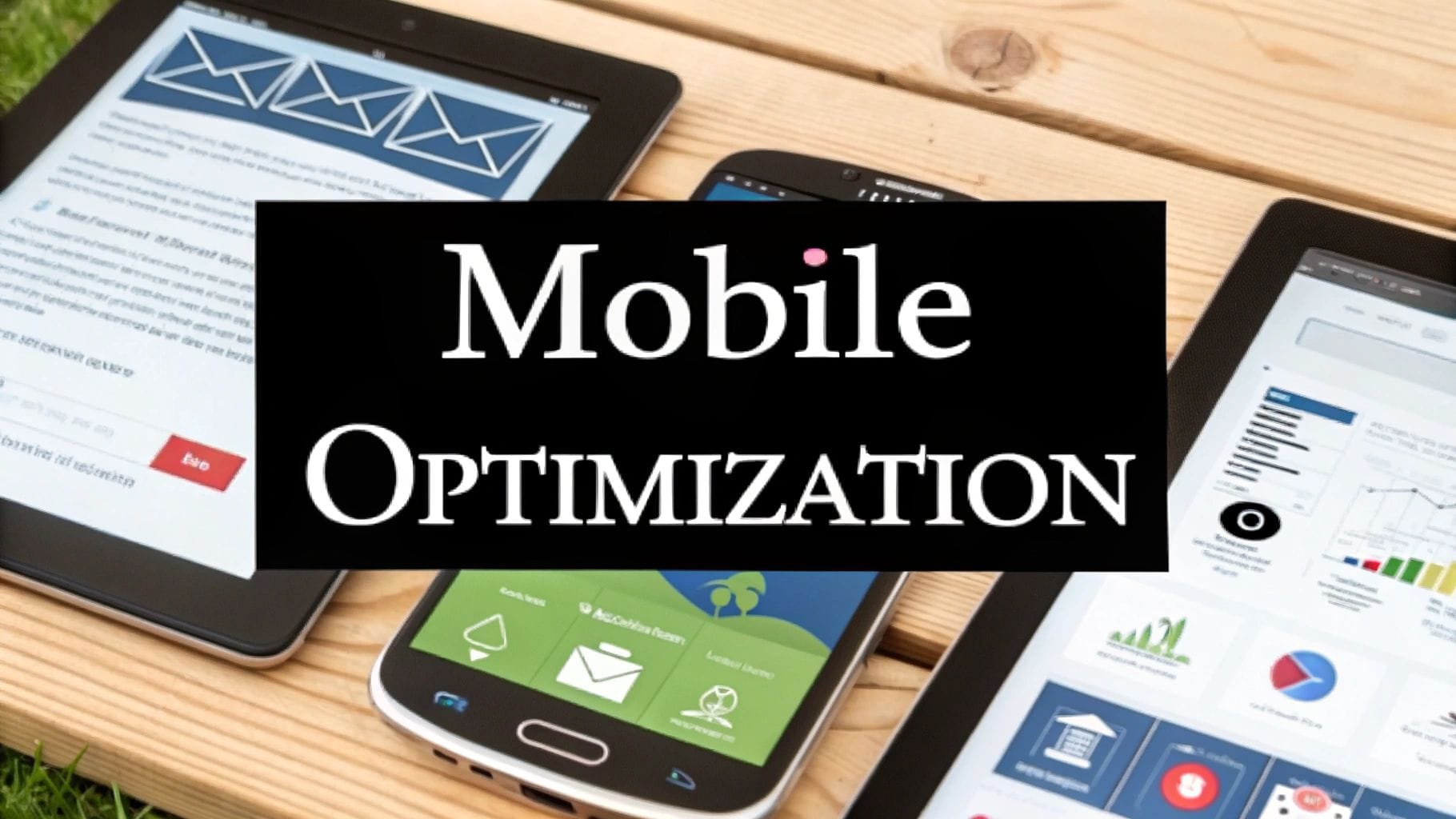How to Increase Email Open Rates: Data-Driven Strategies That Actually Work
How to Increase Email Open Rates: Data-Driven Strategies That Actually Work
Understanding Email Open Rate Benchmarks
Getting a handle on what makes a good email open rate is essential for improving your email marketing. Open rates naturally vary based on different factors, with industry type being one of the biggest influences. The typical successful range falls between 17-28%, but this can differ significantly by sector.
Government emails tend to see the highest engagement, with open rates reaching 28.77%. Hobby-related emails follow closely at 27.74%, while religious organizations achieve 27.62%. At the lower end, marketing and advertising emails average around 17.38%. For more detailed statistics, check out this comprehensive guide on the Mailmunch blog post on email open rates. Want to boost your numbers? Here's a helpful resource on How to improve email open rates by industry in 2023.
Why Industry Benchmarks Matter
Looking at industry averages gives you a solid reference point for your email performance. When you see your open rates falling well below the norm for your sector, it's a clear signal to dig deeper and find ways to improve. These benchmarks help ground your strategy in real data rather than guesswork.
Avoiding Misconceptions About Benchmarks
While industry standards provide useful guidance, they shouldn't be your only measure of success. Your specific audience, email list quality, and overall marketing approach all play crucial roles in determining realistic open rates. Focus on steady improvement over time rather than just hitting an industry average.
How to Use Benchmarks Effectively
Use benchmarks as a starting point to set achievable goals. They can guide your strategy by helping you identify what successful companies in your field are doing right. Look for patterns and proven tactics you can adapt for your own campaigns.
Tracking Your Performance
Keep close tabs on your open rates to spot trends and measure how your improvements are working. Track both overall performance and individual campaign results. This detailed monitoring helps you understand what connects with your audience and what needs adjustment, leading to better results over time.
Mastering Email Personalization Techniques

Email personalization has evolved far beyond just adding someone's name to a message. The real power comes from creating individualized experiences that speak directly to each subscriber's interests and needs. Let's explore how companies use smart techniques like behavioral triggers and dynamic content to boost their email performance. For more insights, check out our guide on Tips to improve community management.
Understanding Behavioral Triggers
Think of behavioral triggers as your email's perfect timing system. When a subscriber takes a specific action - like abandoning their shopping cart - it prompts a relevant follow-up email. For example, sending a gentle reminder about forgotten items along with a small discount can effectively bring customers back to complete their purchase. This approach works because it responds to real customer actions at just the right moment.
Implementing Dynamic Content
Dynamic content adapts your email's message based on what you know about each reader. Picture sending an email that shows different products to different people based on what they've bought before. If someone regularly buys running gear, they'll see new athletic wear rather than dress shoes. This makes each email feel personally curated for the recipient.
Segment-Specific Messaging: The Power of Targeted Communication
Breaking down your email list into smaller, focused groups makes your messages more relevant. For instance, a clothing store might create separate email campaigns for men's, women's, and children's clothing buyers. The numbers show why this matters: personalized subject lines increase open rates by 50%, while targeted campaigns can boost email revenue by an impressive 760%. Some retail brands have even doubled their open rates through smart personalization.
But here's an important note - personalization isn't one-size-fits-all. Some industries, like banking and insurance, actually see better results with more standardized approaches. Learn more in Mailmodo's email marketing statistics guide.
Building a Sustainable Personalization Strategy
The key to successful personalization is finding the right balance. Too much personalization can feel creepy, while too little might not make an impact. Start with basic personalization, test different approaches, and gradually add more sophisticated elements as you learn what works for your audience.
Balancing Automation with Authenticity
While automation helps deliver personalized emails at scale, the human touch still matters. Focus on writing emails that sound natural and helpful rather than robotic or sales-focused. This creates genuine connections with your subscribers and leads to better long-term engagement.
Crafting Subject Lines That Drive Opens

The subject line is your golden ticket to getting your email opened and read. Think of it as a headline that needs to instantly grab attention in a crowded inbox. Learning to write compelling subject lines is a fundamental skill that directly impacts your open rates and the success of your email campaigns.
Think about it, nowadays when an email lands in primary, gmail or the app you use sends you a push notification. Just like other apps do.
If an app has a notification saying 20% off on your next ride. You're like meh.
On the other hand, if it says. "your emails are meh". feels like i've personally written it to you right?
You'd want to know why I said that.
That's the trick.
The Psychology of Opening Emails
We all make split-second decisions about which emails to open based on a few key factors. The sender's name, subject line, and our perception of the email's value all influence that choice. Smart email marketers know that creating mild FOMO (fear of missing out) or highlighting exclusive content can boost open rates by 20-30%. But overdoing urgency or hype can backfire and send your emails straight to spam. You might be interested in: Tips for email security in 2024.
Proven Formulas for Compelling Subject Lines
While no single formula works every time, certain approaches consistently get results. Questions work well because they spark curiosity - instead of announcing "New Winter Collection Available," try "Looking for the Perfect Winter Coat?" Another effective tactic is deep personalization. Going beyond just using first names to reference specific past purchases or browsing behavior can increase open rates by up to 25%.
Creating Urgency and Curiosity
Time-sensitive offers can motivate quick action, but they need to feel authentic. Simple phrases like "24 Hours Left" or "Final Day" often work better than excessive punctuation or ALL CAPS (which can trigger spam filters). The key is building genuine curiosity without crossing into clickbait territory. Your subject line should give an accurate preview of what's inside.
Communicating Value Without Overselling
Be crystal clear about what's in it for the reader. Whether it's a special discount, insider tips, or relevant industry news, the benefit should be obvious. But resist the urge to overpromise or use hyperbole. Building trust through honest, straightforward subject lines leads to consistently higher open rates over time.
Testing and Refining Your Approach
Like any marketing tactic, subject lines need ongoing testing and optimization. Run A/B tests comparing different versions to see what resonates with your audience. Track metrics like open rates, click-throughs, and unsubscribes to gather data on what works. Use those insights to continually refine your approach. Each test provides valuable clues about the messaging that best connects with your subscribers.
Optimizing Send Times and Frequency

Getting your email timing right can make or break your campaigns. Even the most carefully crafted message will go unnoticed if it lands in inboxes at the wrong moment. Let's explore how to nail both the timing and frequency of your emails to get the best possible open rates.
Finding the Optimal Send Time
There's no single "perfect" time that works for everyone. Your ideal sending schedule depends on your specific audience and their habits. B2B audiences often check email during work hours, while consumers may be more likely to engage in evenings or on weekends. Start by understanding when your subscribers are most active.
Managing Global Campaigns Across Time Zones
Working with a global audience adds complexity to email timing. An email sent at 9 am in New York arrives at 2 pm in London and 10 pm in Tokyo. This is where time zone segmentation becomes essential. Tools like Inagiffy help by automatically sending emails at the right local time for each recipient.
Testing and Validating Sending Schedules
The best way to find your audience's preferred timing is through testing. Try A/B testing different send times with small segments of your list and track which gets better open rates. Begin with common best practices, then adjust based on your results. Your data will reveal patterns specific to your subscribers.
Determining the Right Email Frequency
How often you email matters as much as when you send. Too many messages can overwhelm subscribers and drive them away through email fatigue. Too few can make them forget about you. Finding the right balance takes careful planning and monitoring.
Strategies for Optimal Email Frequency
Consider offering subscribers choices about how often they hear from you. Some may want daily updates while others prefer weekly digests. Watch your unsubscribe rates closely - a sudden jump could mean you're sending too frequently. Make adjustments based on this feedback.
Using AI and Automation for Personalized Delivery
Smart email tools now analyze individual subscriber behavior to determine the best sending time for each person. This means your messages arrive when subscribers are most likely to open them. Inagiffy makes this technology accessible to businesses of all sizes, helping you send emails that feel personal while reaching large audiences efficiently.
Building and Maintaining List Quality
The foundation of high open rates starts with a healthy email list. Rather than focusing solely on subscriber count, it's essential to prioritize the engagement level and quality of your audience. Let's explore proven methods for growing your subscriber base authentically while keeping your list clean and engaged.
Growing Your List Organically
Building an authentic subscriber base requires a thoughtful approach. Instead of purchasing email lists, which can damage your sender reputation (see: What Is Email Reputation? All You Need to Know), focus on attracting subscribers naturally. Offer something valuable in exchange for signups, like downloadable guides or exclusive content. Keep your signup forms simple and prominent on your website to encourage genuinely interested subscribers.
The Double Opt-In Advantage
Using a double opt-in process adds an extra verification step - subscribers must confirm their subscription via email before being added to your list. While this additional step may seem like a barrier, it actually helps screen out fake or inactive email addresses. The result? Better open rates and improved deliverability since your list consists of verified, interested readers.
Re-Engaging Dormant Subscribers
Inactive subscribers can hurt both your open rates and sender reputation. Identify subscribers who haven't engaged with your emails in several months and try to bring them back through targeted re-engagement campaigns. This could include special offers, exclusive content, or a simple check-in asking about their preferences. For those who remain unresponsive, removing them helps maintain strong engagement metrics.
Balancing List Cleaning with Growth
Finding the right balance between list hygiene and expansion is key. Set clear guidelines for managing inactive subscribers - for example, removing those who haven't opened emails in 6 months. Monitor your list health regularly through engagement metrics while continuing organic growth efforts. This balanced approach leads to consistently strong open rates.
Strategic Sunset Policies for List Health
A well-designed sunset policy helps gracefully manage inactive subscribers. Send a final re-engagement campaign to long-term inactive subscribers, perhaps with an appealing offer to stay subscribed. If they don't respond, remove them from your list to maintain high engagement rates. This focused approach on active subscribers naturally improves your email marketing results and deliverability.
Measuring and Improving Performance

Building a strong email marketing program requires careful analysis and constant refinement. Top marketers understand that success comes from measuring multiple metrics and continuously testing different approaches. Rather than focusing solely on basic metrics, they track how different elements work together to drive results. For more insights, check out our guide on How to use AI marketing tools to power your marketing messages.
Key Metrics to Track
While open rates provide a starting point, several other metrics offer deeper insights into email performance. Click-through rates (CTR) show how effectively your content and calls-to-action engage readers. Unsubscribe rates help identify potential issues with email frequency, content relevance, or overall messaging approach.
MetricDescriptionOpen RatePercentage of recipients who opened your emailClick-Through RatePercentage of recipients who clicked a link in your emailUnsubscribe RatePercentage of recipients who unsubscribed after receiving your email
Looking at these metrics together paints a complete picture. For example, if you see high open rates but low click-through rates, your subject lines are working but the email content needs improvement.
A/B Testing for Continuous Improvement
A/B testing (also called split testing) helps you find what works best with your audience. The process involves sending two slightly different email versions to separate audience segments. You might test different subject lines, sender names, content formats, or calls-to-action. By comparing how each version performs, you can spot effective elements and keep improving your approach.
Avoiding Common A/B Testing Pitfalls
When running tests, focus on changing just one element at a time. Testing multiple changes makes it impossible to identify which factor actually drove any improvements. Also make sure to test with large enough audience samples to get reliable results - small test groups can lead to misleading conclusions.
Creating Feedback Loops for Long-Term Success
Building feedback loops helps you steadily improve results over time. This means regularly reviewing performance data, finding areas to enhance, making targeted changes, and measuring the impact. When combined with tools like Inagiffy, this data-driven approach helps you create personalized emails that connect with readers and drive engagement.
Looking to take your email marketing further? Inagiffy provides complete newsletter services covering everything from technical setup to content creation. We focus on growing both readership and revenue. Visit Inagiffy to learn more about how we can help.
Comments
Your comment has been submitted successfully!